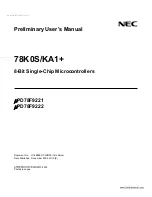MPC563XM Reference Manual, Rev. 1
1270
Freescale Semiconductor
Preliminary—Subject to Change Without Notice
NOTE
The individual Rx Mask per Message Buffer feature may not be available in
low cost MCUs. Please consult the specific MCU documentation to find out
if this feature is supported.
28.2.3
Modes of Operation
The FlexCAN module has four functional modes: Normal Mode (User and Supervisor), Freeze Mode,
Listen-Only Mode and Loop-Back Mode. There are also three low power modes: Disable Mode, Doze
Mode and Stop Mode.
•
Normal Mode (User or Supervisor):
In Normal Mode, the module operates receiving and/or transmitting message frames, errors are
handled normally and all the CAN Protocol functions are enabled. User and Supervisor Modes
differ in the access to some restricted control registers.
•
Freeze Mode:
It is enabled when the FRZ bit in the MCR Register is asserted. If enabled, Freeze Mode is entered
when the HALT bit in MCR is set or when Debug Mode is requested at MCU level. In this mode,
no transmission or reception of frames is done and synchronicity to the CAN bus is lost. See
Section 28.5.9.1, “Freeze Mode,”
for more information.
•
Listen-Only Mode:
The module enters this mode when the LOM bit in the Control Register is asserted. In this mode,
transmission is disabled, all error counters are frozen and the module operates in a CAN Error
Passive mode [Ref. 1]. Only messages acknowledged by another CAN station will be received. If
FlexCAN detects a message that has not been acknowledged, it will flag a BIT0 error (without
changing the REC), as if it was trying to acknowledge the message.
•
Loop-Back Mode:
The module enters this mode when the LPB bit in the Control Register is asserted. In this mode,
FlexCAN performs an internal loop back that can be used for self test operation. The bit stream
output of the transmitter is internally fed back to the receiver input. The Rx CAN input pin is
ignored and the Tx CAN output goes to the recessive state (logic ‘1’). FlexCAN behaves as it
normally does when transmitting and treats its own transmitted message as a message received from
a remote node. In this mode, FlexCAN ignores the bit sent during the ACK slot in the CAN frame
acknowledge field to ensure proper reception of its own message. Both transmit and receive
interrupts are generated.
•
Module Disable Mode:
This low power mode is entered when the MDIS bit in the MCR Register is asserted. When
disabled, the module shuts down the clocks to the CAN Protocol Interface and Message Buffer
Management sub-modules. Exit from this mode is done by negating the MDIS bit in the MCR
Register. See
Section 28.5.9.2, “Module Disable Mode,”
for more information.
•
Doze Mode:


















